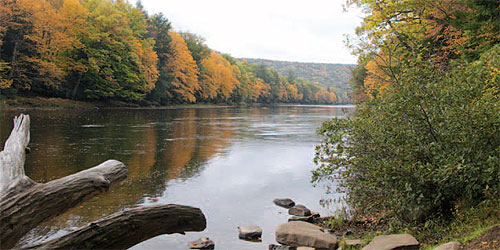WPC’s Approach to Watershed Conservation
As the grassroots watershed conservation movement has grown, the Western Pennsylvania Conservancy’s Watershed Conservation Program has been involved every step of the way.
Founded in 2001 as the Watershed Assistance Center, the program, now based in Blairsville, has worked with more than 500 watershed partners in all phases of restoring and protecting aquatic-based ecosystems.
“As soon as we established the center, our phone began ringing off the hook, and within two years we were up to a staff of 15,” said WPC’s Senior Director of Watershed Conservation and Conservation Services Nick Pinizzotto. ”Groups were getting millions of Growing Greener dollars from the state, but very few had the experience to obtain and use the money. We started as an assistance center, but now we do everything from scientific assessments to working with farmers and designing and constructing physical projects. We’re a comprehensive watershed conservation resource center unlike any other in the country.”

The Clarion River was once considered one of the “worst streams in the state.” Through conservation practices and resolve of citizens, it is now considered one of the most scenic.
Although the public may seldom see WPC staff members and volunteers as they remove dams or build habitat and bank protection structures on remote streams, their efforts have meant cleaner water for drinking and recreation in the hundreds of watersheds where they have worked.
Current efforts are focused on Little Mahoning and Tubmill creeks in the Ohio River watershed, with several other initiatives within the Juniata, West Branch Susquehanna and upper Allegheny River watersheds.
Empowering watershed residents to play a role in conservation is a key component of WPC’s mission. “Every watershed conservation plan begins with a public meeting because we want people to know what we’re doing and to tell us what they’d like to see,” said Kylie Maland, WPC watershed manager of the Upper Allegheny River and Lake Erie region. “We interview individuals based on the recommendations of a local steering committee. Those folks, in turn, make additional referrals until we have a web of people invested in improving the watershed.”
"The public is asked to review the draft conservation plan and celebrate its completion," Maland said. “We invigorate people to begin implementation, and seek feedback on our progress with public surveys at coffee shops and other local gathering spots.
In addition to the hundreds of grassroots watershed associations and other volunteer-based organizations, WPC also works with government partners. “We’ve done a lot of work with the Pennsylvania Fish and Boat Commission, conducting freshwater mussel and fish surveys, stabilizing stream banks and improving aquatic habitat,” said Pinizzotto. “And we have partnered with the Pennsylvania Department of Environmental Protection on dozens of abandoned mine drainage projects, including construction of treatment facilities.”
WPC assists the U.S. Department of Agriculture Natural Resource Conservation Service (NRCS) in encouraging best practices on farmlands. “In many cases NRCS has limited staff resources to meet the demands of agricultural producers who want to improve conservation practices on their farms,” said Pinizzotto.
“We help farmers navigate complicated government programs so that the direct cost to them is limited. In many cases, we are able to design and implement conservation practices such as stream bank fencing and stabilized stream crossings for cattle and equipment. We also develop state and federal manure management plans for farmers and help them understand how practices like rotational grazing can regenerate paddocks and reduce erosion.”
Rural roads are also a major cause of stream sedimentation. In just the past two years, WPC has worked with townships and county conservation districts to improve drainage and stabilize nearly 15 miles of unpaved surfaces.
Impacts to ground and surface water often occur out of sight, and WPC has spearheaded the replacement and repair of aging septic systems. “Townships are getting better about enforcing sewage violations, but it’s a touchy situation, since failing systems can be a huge expense for property owners,” said Jennifer Bennett, WPC watershed manager for the Juniata and Potomac Region. Effluent in that region impacts High Quality Coldwater Fisheries and accounts for four percent of pollution in the Chesapeake Bay.
WPC’s Morrison Cove On-Lot Septic Program has educated 90 homeowners in septic system maintenance and distributed more than $60,000 toward replacing or repairing systems since 2006. “The cost-sharing has been especially popular since there was no other help for landowners before our program came along,” Bennett said.
WPC also reaches out to schools in project areas, such as Marion Center Area High School in the Little Mahoning watershed, where 100 ninth grade earth science students participated in two stream excursions this year. “They saw fish and bugs and mussels and loved it,” said Eric Chapman, WPC director of aquatic science. “They took part in actual scientific studies. It’s something they talked about for a long time.”
